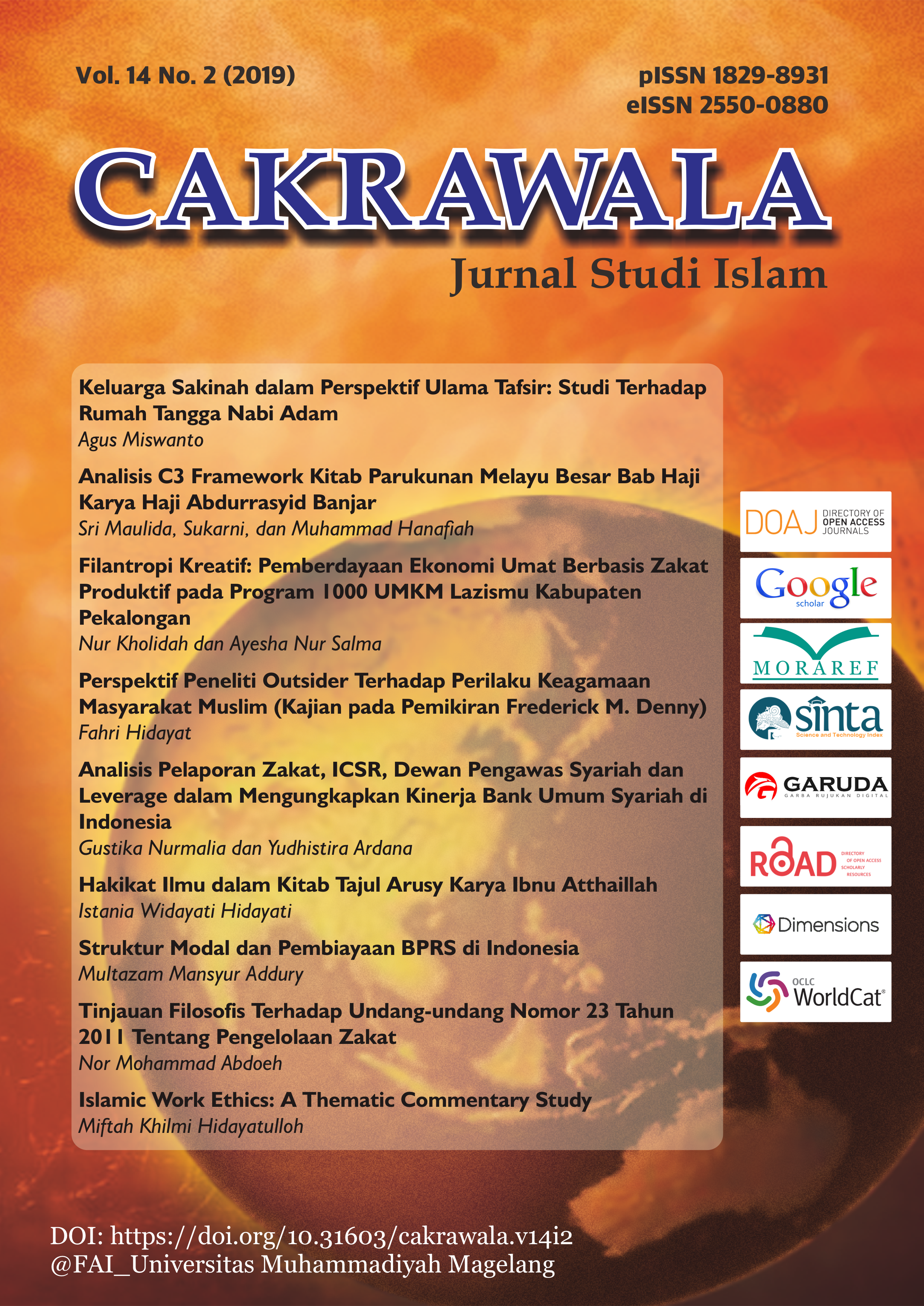Main Article Content
Abstract
The large number of divorces that occur in Indonesia is due to the failure of the establishment of a Sakinah family so that it is a very fundamental case in Islamic law. Therefore, the purpose of this study is to reveal the values of the sakinah family placed by the Prophet Adam and Eve. This study uses a descriptive literature study using content analysis methods and comparative approaches. QS. Al-Baqarah verses 35-37 become the main object with the focus of the study on four interpretations, namely al-Baghawi, Ibn Kathir, al-Alusi, and al-Maraghi. This research found that 1) family life is a nature from the time of Azali; 2) sakinah family can be realized with equality in a love relationship, fulfillment of basic household needs, obedience to sharia rules; 3) sakinah life can be damaged due to violations of Sharia rules and third party intervention; and 4) the destruction of sakinah life can be fixed with each party having an awareness of the mistakes that have been made and then repenting to Allah SWT
Keywords
Article Details

This work is licensed under a Creative Commons Attribution-NonCommercial 4.0 International License.
References
- Al-Alusi, A. S. al-S. M. ibn A. ibn M. al-H. (1994). Ruh al-Ma’ani fi Tafsir al-Qur’an al-’Adhim wa al-Sab’u al-Matsani. (M. Al-Amad, Ed.) (Cet. I). Beirut, Lebanon: Dar al-Kutub al-’Ilmiyah.
- Al-Baghawi, A.-M. I.-M. (1997). Ma’alim al-Tanzil. (M. A. Al-Namr, Ed.) (Cet. IV). Beirut, Lebanon: Dar al-Thaibah li an-nasyr wa al-tauzi’.
- Al-Maraghi, A. M. (1946). Tafsir al-Maraghi (Cet. I). Kairo, Mesir: Syirkah maktabah wa Mathba’ah Musthafa al-babi al-halabi.
- Ali, Z. (2018). Hukum Perdata Islam di Indonesia (Cet. 1). Jakarta: Sinar Grafika.
- Askar, R. A., & Yapono, A. (2016). Abu Muhammad al-Husain bin Mas’ud al-Baghawi’s Concept of ’Uluww al-Isnad in Narating Hadith. Kalimah, 14(1), 53–80. http://doi.org/10.21111/klm.v14i1.361
- Asmaya, E. (2012). Implementasi Agama dan Mewujudkan Keluarga Sakinah. Komunika, 6(1), 1–11.
- Chadijah, S. (2018). Karakteristik Keluarga Sakinah dalam Islam. Rausan Fikr, 14(1), 113–128.
- Hsieh, H. F., & Shannon, S. E. (2005). Three Approaches to Qualitative Content Analysis. Qualitative Health Research, 15(9), 1277–1288. http://doi.org/10.1177/1049732305276687
- Ibn-Katsir, A. F. I. I.-U. (1999). Tafsir al-Qur’an al-Adhim. (S. I.-M. Salamah, Ed.). Beirut, Lebanon: Dar al-Taubah Linasyr wa al-Tauzi’.
- Jannah, M., Mugnisjah, W. Q., & Gunawan, A. (2015). Kajian Konsep Taman Islam Berdasarkan Alquran dan Hadits. El-Harakah, 17(1), 1–17.
- Kabalmay, H. A. (2015). Kebutuhan Ekonomi dan Kaitanya dengan Perceraian (Studi atas cerai Gugat di Pengadilan Agama Ambon). Tahkim, 11(1), 47–67.
- Khalid, M. R. (2017). Metodologi Kitab Ma’alim al-Tanzil Karya al-Baghawi. Adabiyah, 17(2), 109–123.
- Miswanto, A. (2013). Agama, Keyakinan dan Etika. (M. Z. Arofi, Ed.) (Cet. III). Magelang: P3SI UMM.
- Nurdin. (2013). Analisis Penerapan Metode bi al-Ma’sur dalam Tafsir Ibn Katsir terhadap Penafsiran Ayat-Ayat Hukum. Asy-Syir’ah, 47(1), 83–112.
- Rais, I. (2014). Tingginya Angka Cerai Gugat (khulu’) di Indonesia: Analisis Kritis Terhadap Penyebab dan Alternatif Solusi Mengatasinya. Al-’Adalah, 12(1), 191–204.
- Setianingsih, Y. (2017). Melacak Pemikiran Al-Alusi dalam Tafsir Ruh al-Ma’ani. Kontemplasia, 5(1), 235–259.
- Setiawan, M. A. (2015). Konsep Kota Layak Huni (livable City) dalam Alqur’an. Universitas Islam Negeri Walisongo Semarang.
- Yahaya, A. M., & Abdullah, M. (2014). Reform Thoughts in Tafsir al-Maraghi by Syaikh Ahmad Mustafa al-Maraghi. Research in Islamic Studies, 1(2), 63–76.

